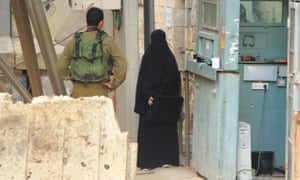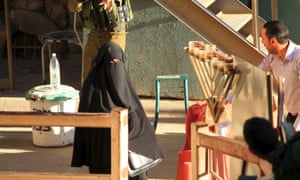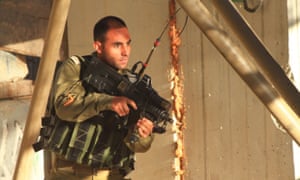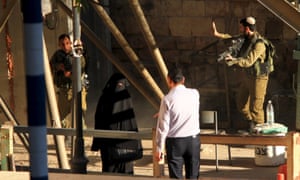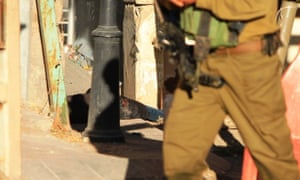Dries van Agt Oud-premierpremier
23 oktober 2015 RSS
Palestijnen: gevangenen in eigen land
'Veel empathie met Israëlische slachtoffers, weinig met Palestijnse. De bezetting wordt vrijwel niet genoemd'
Het geweld in Israël en Palestina escaleert weer. Bij velen heeft zich het beeld gevestigd dat de escalatie deze keer te wijten is aan moordlustige Palestijnen die op weerloze Israëli’s inrijden en insteken.
Ik heb de beelden ook gezien en zal geen van deze daden goedpraten. Zoals ieder weldenkend en welvoelend mens keur ik die daden af. Ze zijn verschrikkelijk. Maar ik ga wel iets over de context vertellen waarin zij plaatsvinden.
Israëls ernstige misvatting
Niemand heeft deze context scherper benoemd dan Gideon Levy, Israëls morele geweten en mijn held. In zijn confronterend artikel “Even Ghandi would understand the Palestinians’ violence” schrijft Levy over de totale ontkenning in Israël van het immense leed dat de Israëlische bezetting de Palestijnen berokkent:
Niemand heeft deze context scherper benoemd dan Gideon Levy, Israëls morele geweten en mijn held. In zijn confronterend artikel “Even Ghandi would understand the Palestinians’ violence” schrijft Levy over de totale ontkenning in Israël van het immense leed dat de Israëlische bezetting de Palestijnen berokkent:
“Israel thought it could do anything and pay no price. … It thought that nearly every week a boy or teenager could be killed by soldiers, and the Palestinians would stay quiet. It thought military and political leaders could back the crimes and no one would be prosecuted. It thought houses could be demolished and shepherds expelled, and the Palestinians would accept it all humbly. It thought settler thugs could damage, burn and act as if Palestinian property were theirs, and the Palestinians would bow their heads.
It thought that Israeli soldiers could burst into Palestinian homes every night and terrorize, humiliate and arrest people. That hundreds could be arrested without trial. That the Shin Bet security service could resume torturing suspects with methods handed down by Satan.
That Israel could destroy Gaza once every two to three years and Gaza would surrender and the West Bank remain calm. That Israeli public opinion would applaud all this, with cheers at best and demands for more Palestinian blood at worst, with a thirst that’s hard to understand. And the Palestinians would forgive.”
Lont in het kruitvatVoor de actuele geweldsescalatie was de situatie rond de Haram-al Sharif, de op twee na heiligste plek in de islam (door Israël aangeduid als “Tempelberg”), de lont in het kruitvat. Premier Netanyahu kan nu wel bezweren dat hij de afspraken die eerder met de Palestijnen en met Jordanië over het beheer van de Haram-al Sharif zijn gemaakt zal blijven nakomen. Maar voor alle Palestijnen is het duidelijk dat Netanyahu zich omringd heeft met politieke bondgenoten die hopen dat de islamitische heiligdommen op de Haram-al Sharif verdwijnen, opdat daar de joodse tempel herbouwd kan worden. De Palestijnen kennen Netanyahu’s mantra over Jeruzalem: “Jerusalem has and always will only be the capital of the Jewish people.”
Wie de religieuze, culturele, economische en politieke betekenis van Oost-Jeruzalem voor de Palestijnen kent, die zal begrijpen dat Israëls annexatie van Oost-Jeruzalem in wezen een oorlogsverklaring aan de Palestijnen was. Dat de discriminatie en achterstelling waar de plaatselijke Palestijnse bevolking aan blootstaat, terwijl de nederzettingen gedijen en extremistische kolonisten door Netanyahu’s regering actief gesteund worden, een recipe for disaster is.
Geweld als regel
Voor de bezette Palestijnen is geconfronteerd worden met grof geweld een dagelijkse realiteit – de regel. Voor Israël is het de uitzondering. Nu een aantal Palestijnen is doorgedraaid en aanslagen op Israëli’s heeft gepleegd, schroeft Israël het geweld nog verder op. Tientallen Palestijnen zijn alweer gedood en duizenden gewond geraakt, van wie velen ernstig.
Voor de bezette Palestijnen is geconfronteerd worden met grof geweld een dagelijkse realiteit – de regel. Voor Israël is het de uitzondering. Nu een aantal Palestijnen is doorgedraaid en aanslagen op Israëli’s heeft gepleegd, schroeft Israël het geweld nog verder op. Tientallen Palestijnen zijn alweer gedood en duizenden gewond geraakt, van wie velen ernstig.
Ik zal u video’s besparen waarop te zien is hoe Palestijnen die van een geweldpleging verdacht werden en die geen direct gevaar (meer) vormden, standrechtelijk zijn geëxecuteerd. Deze video wil ik echter graag met u delen. Het toont het gezicht van de bezetting zoals Palestijnen dat elke dag zien. Een Palestijnse jongen, die aan een demonstratie heeft deelgenomen, wordt gearresteerd. Door wel tien man wordt hij in elkaar getrapt en geslagen, nadat Israëlische undercoveragenten de Palestijnse demonstranten kort daarvoor hadden opgejut om stenen te gooien. Zo werkt de bezetting.
Wat in deze video te zien is, kan niet begrepen worden als niet bekend is waar de demonstratie plaatsvond: in Palestina. De Palestijnen zijn namelijk gevangenen in eigen land. Het Israëlische leger is geen defensief leger, maar een vijandig bezettingsleger voor hen. Elk volk zou zich daartegen verzetten.
Hier wil ik mijn ongenoegen uiten over de berichtgeving van de NOS, die aandacht aan de geweldsescalatie heeft besteed. Via haar journaals en nieuwsberichten heeft de NOS het beeld versterkt dat Israël defensief en reactief opereert. Geweldsincidenten deden zich vooral in Israël voor, was de boodschap. Veel empathie met Israëlische slachtoffers, weinig met Palestijnse. En de bezetting werd vrijwel niet genoemd.
Wij hebben voor u in kaart gebracht wat de verhouding is in aantallen slachtoffers en waar de dodelijke geweldsincidenten plaatsvonden. Zoals u zult zien vallen de hardste klappen in bezet Palestina, zoals altijd.
Nederlands-Palestijns Bilateraal ForumHet kabinet blijft zich aan de mislukte economische aanpak vastklampen. Over een week vindt in Nederland de tweede editie van het Nederlands-Palestijns Bilateraal Forum plaats. Daarvoor zal een hoge delegatie uit Palestina komen, bestaande uit president Abbas, premier Hamdallah en minister van Buitenlandse Zaken al-Malki.
Dat forum zal alle betrokkenen even een goed gevoel geven – erg gebeurt iets positiefs. Maar in wezen houden we onszelf voor de gek. De economische opbrengst van het forum is een druppel op de gloeiend hete plaat van de bezetting. Die plaat wordt almaar heter. Nog maar een paar dagen geleden zei de Israëlische minister Eli Ben-Dahan: “Palestinians have to understand they won’t have a state and Israel will rule over them.” Op die agressieve politiek zou het kabinet alle aandacht moeten vestigen.
De bezetting gedijt, meer dan ooit. En nu bereiden het Israëlische parlement en de regering-Netanyahu ook nog een wet voor die tot inzet heeft om tegenstanders van de nederzettingen de toegang tot Israël te weren. Zozeer is Israël het land van de kolonisten geworden.




